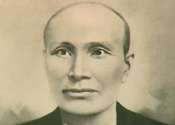Chin Lin Sou
Chin Lin Sou (c. 1837 – 1894) was an influential leader in the Chinese American community and prominent figure in Colorado.[1] He immigrated to the United States from Guangzhou, China, in 1859 at the age of 22. Chin stood out amongst his Chinese peers at the time in the United States as he dressed like a westerner and spoke perfect English.

Background
He worked on the First Transcontinental Railroad as the foreman of a group of Chinese railroad workers, many of whom Chin, himself, recruited and helped to gain passage into the United States. His leadership was important to the construction of the railroad because Chinese railroad workers were used to lay the steel rails. Following the completion of the railroad in 1869 he settled for a time in Black Hawk, Colorado where he was the unofficial leader of a group of Chinese immigrants who settled in a community called Cottonwood.[2]
Chin eventually achieved modest success in mining investments in Central City; by the 1870s, he had earned enough money to bring his family over from China. Upon their arrival, he moved to Denver, where he, as well as his children and descendants, became important figures in the city. He died in 1894 and was buried in Denver's Riverside Cemetery.[1] In April 1901 his body was exhumed and transferred to China.
See also
- Chinese American history
References
- Monnett, John H. (2004). "Sou, Chin Lin". In David J. Wishart (ed.). Encyclopedia of the Great Plains. University of Nebraska Press. p. 146. ISBN 0803247877.
- "Peak to Peak". Rocky Mountain Public Broadcasting Network. Archived from the original on 2008-09-05. Retrieved 2008-11-21.